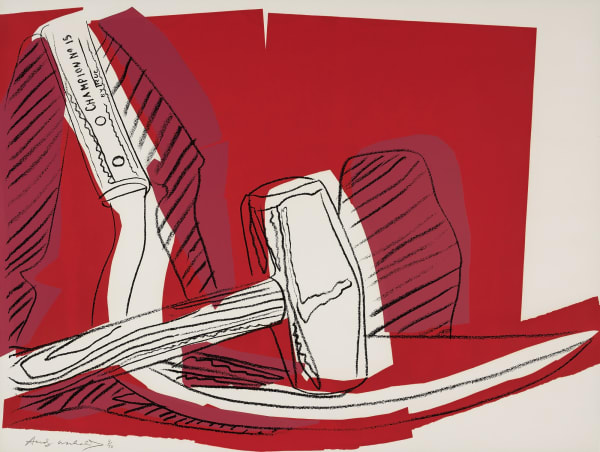-
 (FS II.161)
(FS II.161) -
Andy Warhol Hammer and Sickle (F & S II.161-164)
Meaning & HistoryAfter seeing the Hammer and Sickle graffitied on the streets of Italy, Warhol appropriated the Socialist emblem in his own pop Pantheon. The portfolio is a striking example of the artist's ability to divorce politcally and socially loaded images from their contexts.
Hammer and Sickle is a portfolio of four screenprints self-published by the artist in 1977. They depict the socialist emblem of the two tools, seen on the Soviet Union flag and used to symbolise international Communism. Each print, large in scale, frames the hammer and sickle in a different position, thus dismantling the original symbol that unifies the two.
Hammer and Sickle is arguably one of Warhol’s most nuanced and complex works in terms of his reworking of iconography. The hammer and sickle, though most known for its appropriation during the soviet Union, has a long history of representing the struggle of proletarian workers (constructors and farmers utilising these tools in their daily life). Whilst Warhol was touring Italy for his Ladies and Gentlemen exhibition in 1975, he saw graffiti of the symbol everywhere spray-painted by the Italian populace, who were largely left-wing. Ever-quick to respond to his environment, upon his return, the artist enlisted his studio assistant Ronnie Cutrone to search for representations of communism in bookstores and in shops. Yet, the pair found that nothing would suffice as well as a real hammer and sickle that was eventually purchased from a hardware shop. Its three dimensionality would add dynamism to the final works, as Cutrone laid the tools out in a multitude of ways and photographed them, with Warhol carefully selecting which ones to draw.
The brilliant irony of this transmutation of politically charged symbol into store-purchased product, depicted in a still life, is not lost on the artist and should not escape the viewer’s attention: indeed the sickle distinctly bears the brand name ‘Champion no.15’. Warhol’s positioning of the tools also mirror his detachment from their original connotations by way of changing their original and most-known placement: the sickle appears upside down, in front and across the hammer. Therefore they have become literally and conceptually subverted. So autonomous are Warhol’s hammer and sickle that they begin to fragment and even totally disappear (11.165 and 11.166) against a stark white background – devoid of the propagandistic colours of red and black.
Hammer and Sickle is by no means the first instance that Warhol dealt with communism in his work. He had produced many silkscreens and screenprints of Chinese communist leader Mao Zhedong five years earlier. What it is it about communism that captivated Warhol, arguably the most capitalistic artist of the era? Perhaps the answer lies in Warhol’s wider fascination with what were deemed to be the most powerful images of the twentieth century, images that were revered, although for different reasons – such as Marilyn Monroe, J.F Kennedy and here the Hammer and Sickle. Warhol practiced emotional and artistic distance from these, and in detaching symbols from their political and social contexts, created enduring symbols entirely anew.
Active during the Cold War years, Warhol explored the iconography of soviet leaders in his career famously the Mao portfolio. Towards the end of his life he returned to communism through the Lenin series released in 1987. Explore Andy Warhol prints for sale.
-
-
Buy or sell Hammer & Sickle by Andy Warhol at Andipa Editions
Buy Hammer and Sickle by Andy Warhol
Andipa Editions, as part of Andipa, have been at the forefront of the Warhol market for over 20 years. To enquire about buying a Hammer and Sickle print by Andy Warhol, contact us via sales@andipa.com or on +44 (0) 20 7589 2371.
Sell Hammer and Sickle by Andy Warhol
With a global network of active buyers, Andipa Editions are the place to sell your Andy Warhol Hammer and Sickle print. Straight-forward and stress-free, we manage the process on your behalf and help to maximise your return. For a complimentary valuation of your Hammer and Sickle print, contact us via sales@andipa.com or on +44 (0) 20 7589 2371. To Buy Andy Warhol screen prints for sale contact Andipa Editions.




